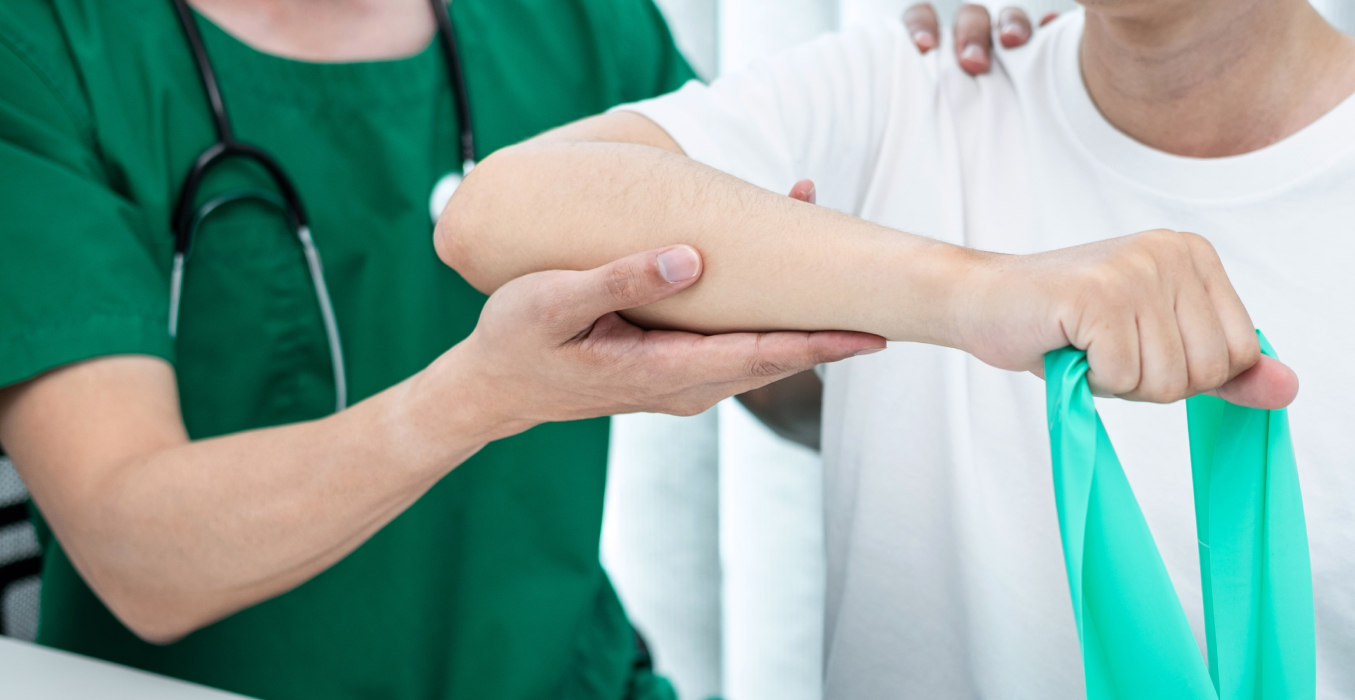Introduction to Tennis Elbow
Tennis elbow, medically termed lateral epicondylitis, is a condition marked by pain on the outer part of the elbow. It is commonly associated with overuse of the forearm’s muscles and tendons, leading to inflammation and micro-tears.
Despite its name, many people beyond tennis players can experience tennis elbow. The focus of treatment is often on relieving pain and restoring normal arm function.
Understanding Tennis Elbow
What is Tennis Elbow?
Tennis elbow results from the overuse of the forearm’s extensor muscles, particularly where the tendons attach to the lateral epicondyle of the elbow.
The condition is characterised by inflammation and micro-tears in the tendon. It is typically caused by repetitive motion or excessive strain, leading to pain and tenderness on the outer elbow.
Symptoms
- Pain radiates from the outside of the elbow into the forearm and wrist.
- Worsening pain with activities that involve gripping or twisting.
- Tenderness on the outside of the elbow.
- Stiffness in the elbow.
- Weakness in the forearm or grip.
Risk Factors
- Repetitive motion of the arm, elbow, wrist, or hand.
- Activities requiring forceful extensions or contractions of the forearm muscles.
- Poor technique in sports or activities can strain the forearm muscles.
Non-Surgical Treatment Options
Non-surgical treatments are the first line of therapy for tennis elbow, focusing on relieving pain and promoting healing. These treatments aim to reduce symptoms without the need for invasive procedures, often involving:
Rest and Activity Modification
Limiting activities that worsen the condition is often the first step in treatment. This includes taking breaks from repetitive tasks and avoiding actions that strain the affected muscles and tendons.
Physical Therapy
A tailored exercise program can be developed to strengthen the forearm muscles, improve flexibility, and reduce stress on the injured tissue. Techniques may also include manual therapy and modalities to decrease pain and inflammation.
Brace and Equipment Adjustments
Wearing a brace or strap around the forearm can reduce stress on the tendons. Adjustments to equipment, such as changing the grip size on racquets or tools, can also help alleviate symptoms.
Medications
Non-steroidal anti-inflammatory drugs (NSAIDs) are commonly used to reduce pain and swelling. However, their effectiveness in treating tennis elbow specifically can vary.
Injections
Corticosteroid injections are sometimes used to provide temporary relief from pain. Recent advances include platelet-rich plasma (PRP) injections, which may promote tendon healing.
Surgical Treatment Options
Surgery is considered for tennis elbow when non-surgical treatments fail to provide relief after a significant period, usually 6 to 12 months. Surgery aims to remove damaged tissue and relieve pain, restoring function in the affected arm.
Types of Surgery
- Open Surgery: The most common approach involves an incision over the elbow to remove diseased muscle and reattach healthy muscle back to the bone.
- Arthroscopic Surgery: A minimally invasive technique using small incisions and specialised instruments to remove damaged tissue.
- Percutaneous Tenotomy: Involves a needle to make small holes in the tendon, stimulating healing without a large incision.
Post-Surgical Care
Post-operative care typically involves rest, followed by a gradual increase in activities. Physical therapy is recommended to regain strength and mobility. Recovery times can vary, but many patients return to normal activities within 4 to 6 months.
Considerations and Risks
Surgery carries risks such as infection, nerve damage, and persistent pain. The decision to proceed with surgery should be made after thoroughly discussing the potential benefits and risks.
Preventive Measures
Preventing tennis elbow involves adopting strategies to reduce undue stress on the forearm muscles and tendons, which can be particularly beneficial for people susceptible to this condition and those recovering from it.
Ergonomic Adjustments
Making ergonomic adjustments involves using proper form and technique during sports or repetitive activities, ensuring that equipment like racquets or tools is appropriately suited to one’s body and skill level, and adjusting the workstation layout to minimise forearm strain.
Strengthening and Flexibility Exercises
Incorporating exercises to strengthen the forearm, wrist, and hand muscles and routines to improve flexibility and prevent stiffness can play a crucial role in preventing tennis elbow.
Activity Modification
Modifying activities by taking frequent breaks during tasks that contribute to tennis elbow and alternating between different tasks to avoid prolonged repetition of the same movements is key to reducing risk.
Protective Equipment
Protective equipment, such as wearing a brace or strap during activities that place excessive stress on the elbow and forearm and using grips or gloves to improve handle ergonomics, can significantly lessen strain and prevent the development of tennis elbow.
Conclusion
Tennis elbow, while commonly associated with sports, can affect anyone performing repetitive arm movements. People can manage symptoms and reduce the risk of recurrence by combining necessary treatment options and preventive measures. Recognising early signs and seeking appropriate treatment is important to maintain arm health and functionality.

